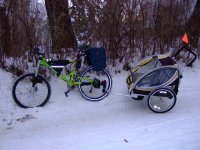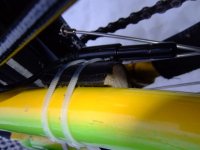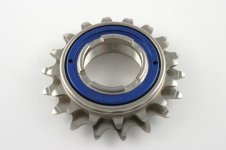I built up a Cannondale Jekyll with a BMC V2S some months ago. Here is a build log and riding impressions.
Some background. I have been riding a Specialized Stumpjumper with a 9C@72V past year and a half. While the Stumpjumper has admirable handling and feel in its original state, adding the weight of the 9C and 12kg of batteries made handling a dud.
Therefore, goals for this build were thus both a stiffer frame and less added weight. Stiffness comes from tubing diametre on a bike frame, so a Cannondale oversized aluminium frame was a natural choice. Suspension flex was another culprit on the Stumpjumper. The Cannondale Jekyll is built according to the theme less is better. One big diametre stanchion in the lefty fork is both stiffer and lighter than the two stanchions in a conventional fork. One beefy joint in the mono-pivot rear suspension is better than the numerous joints in most rear suspensions. The eBike components I picked are the popular BMC V2S and Clyte 35A analog controller. The BMC is a bit lighter than the 9C, but the biggest imrovement is a significantly better torque and efficiency at high loads and low speeds (that is going up hills and/or pulling my kid in a trailer.
The controller is mounted to the seatpost with metal straps fastened to the heatsink screws on the back of the controller. The battery triangle mounted. 6kg in the triangle perfectly balances the 4.5 kg of the motor in the rear. Longitutinal CG just at front tip of saddle. End result so far looks like this:
View attachment 2
Checking the axle in the dropout I found quite a bit of wiggle. To make it fit snugly I filed the dropout a bit deeper and added steel wedges to fill the gap in the original dropout. No idea why the dropout is like so. The previous Stumpjumper had forged steel dropouts. Super strong and nearly impossible to file. The aluminum in the cannondale is on the other hand quite soft.

I was concerned with the point load where the small ridge on the motor axle would contact contacts Alu dropout. Therefore I put washers on inside and outside of the axle to spread force over a bigger area of the dropout. A 5mm spacer was added to freewheel side to fit 9sp freewheel. On the brake side I mounted a torque arm to the disk brake eyelet. The black attachment is the trailer hitch for my Bell kids trailer.
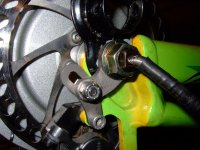
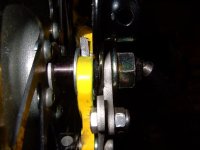
I've got 16s of A123 15Ah pouches that I want to build a battery from, but haven't figured out how to solder the stubborn aluminum tabs yet.
http://www.endless-sphere.com/forums/viewtopic.php?f=14&t=21519
For now I'm using one or two of my other batteries for 36 or 72V.
I also bought a cycle analyst direct plugin, but didn't figure out how to wire it. Once I have that wired I can give some speed and Wh/km figures.
http://www.endless-sphere.com/forums/viewtopic.php?f=2&t=21931
In summary to be fixed is: '
Learn howto solder A123 tabs, build battery.
Learn how to connect CA direct plug-in to Clyte 35A analog controller and install.
See if I can file left hand shifters (Deore XT) to clear throttle.
Riding impressions
The Cannondale frame carries the added 10kg BMC motor and battery ok. Certainly much better than the weaker Specialized Stumpjumper frame dealt with 18kg 9C + battery. I can do relatively straight singletrack trails, but have to avoid the really challenging trails and hills. The added weight makes steering reaction much slower compared to the bare Cannondale (or any similar MTB)
I crashed pretty hard once (lost control after landing a jump). While I tore my pants, and bent the brake disc and handlebars the eBike parts survived fine.
I had to set the damping on the front and rear shocks to max, and the bike is still a bit underdamped. Bike shocks are just not made for the heavier load of ebike stuff.
I'm using the bike mostly for commuting, and it does fine in the urban jungle. I can go down stairs and curbs, but shredded tires trying to go up. Now I run Schwalbe big apples which do very well on the pavement. They obviously don't have good grip on dirt or grass though. Despite soft rubber (therefore good asphalt grip) they seem to not wear too quickly (compared to some Hutchinson high end tires, soft compound I tried before)
Now in the winter I found that the Big apples (surprisingly) have a decent grip on snow and walking paths. It is of course worse on the compressed compressed snow on the car lanes, so I have to get my studded tires on soon.
Anoter winter issues that came up one cold morning was that the 9speed freewheel does not engage. Temp was -30C and I guess the grease inside had stiffened. BMC motor worked though and after biking a bit the freewheel started working right. I have the same brand ebikes.ca 7sp freewheel on the older build, but did not have low temp issues with that one.
Overall the big full suspension Cannondale bike handles better in winter than the previous eBike. The substantial 5" shocks are good for obstacles hidden under snow.
Some background. I have been riding a Specialized Stumpjumper with a 9C@72V past year and a half. While the Stumpjumper has admirable handling and feel in its original state, adding the weight of the 9C and 12kg of batteries made handling a dud.
Therefore, goals for this build were thus both a stiffer frame and less added weight. Stiffness comes from tubing diametre on a bike frame, so a Cannondale oversized aluminium frame was a natural choice. Suspension flex was another culprit on the Stumpjumper. The Cannondale Jekyll is built according to the theme less is better. One big diametre stanchion in the lefty fork is both stiffer and lighter than the two stanchions in a conventional fork. One beefy joint in the mono-pivot rear suspension is better than the numerous joints in most rear suspensions. The eBike components I picked are the popular BMC V2S and Clyte 35A analog controller. The BMC is a bit lighter than the 9C, but the biggest imrovement is a significantly better torque and efficiency at high loads and low speeds (that is going up hills and/or pulling my kid in a trailer.
The controller is mounted to the seatpost with metal straps fastened to the heatsink screws on the back of the controller. The battery triangle mounted. 6kg in the triangle perfectly balances the 4.5 kg of the motor in the rear. Longitutinal CG just at front tip of saddle. End result so far looks like this:
View attachment 2
Checking the axle in the dropout I found quite a bit of wiggle. To make it fit snugly I filed the dropout a bit deeper and added steel wedges to fill the gap in the original dropout. No idea why the dropout is like so. The previous Stumpjumper had forged steel dropouts. Super strong and nearly impossible to file. The aluminum in the cannondale is on the other hand quite soft.

I was concerned with the point load where the small ridge on the motor axle would contact contacts Alu dropout. Therefore I put washers on inside and outside of the axle to spread force over a bigger area of the dropout. A 5mm spacer was added to freewheel side to fit 9sp freewheel. On the brake side I mounted a torque arm to the disk brake eyelet. The black attachment is the trailer hitch for my Bell kids trailer.


I've got 16s of A123 15Ah pouches that I want to build a battery from, but haven't figured out how to solder the stubborn aluminum tabs yet.
http://www.endless-sphere.com/forums/viewtopic.php?f=14&t=21519
For now I'm using one or two of my other batteries for 36 or 72V.
I also bought a cycle analyst direct plugin, but didn't figure out how to wire it. Once I have that wired I can give some speed and Wh/km figures.
http://www.endless-sphere.com/forums/viewtopic.php?f=2&t=21931
In summary to be fixed is: '
Learn howto solder A123 tabs, build battery.
Learn how to connect CA direct plug-in to Clyte 35A analog controller and install.
See if I can file left hand shifters (Deore XT) to clear throttle.
Riding impressions
The Cannondale frame carries the added 10kg BMC motor and battery ok. Certainly much better than the weaker Specialized Stumpjumper frame dealt with 18kg 9C + battery. I can do relatively straight singletrack trails, but have to avoid the really challenging trails and hills. The added weight makes steering reaction much slower compared to the bare Cannondale (or any similar MTB)
I crashed pretty hard once (lost control after landing a jump). While I tore my pants, and bent the brake disc and handlebars the eBike parts survived fine.
I had to set the damping on the front and rear shocks to max, and the bike is still a bit underdamped. Bike shocks are just not made for the heavier load of ebike stuff.
I'm using the bike mostly for commuting, and it does fine in the urban jungle. I can go down stairs and curbs, but shredded tires trying to go up. Now I run Schwalbe big apples which do very well on the pavement. They obviously don't have good grip on dirt or grass though. Despite soft rubber (therefore good asphalt grip) they seem to not wear too quickly (compared to some Hutchinson high end tires, soft compound I tried before)
Now in the winter I found that the Big apples (surprisingly) have a decent grip on snow and walking paths. It is of course worse on the compressed compressed snow on the car lanes, so I have to get my studded tires on soon.
Anoter winter issues that came up one cold morning was that the 9speed freewheel does not engage. Temp was -30C and I guess the grease inside had stiffened. BMC motor worked though and after biking a bit the freewheel started working right. I have the same brand ebikes.ca 7sp freewheel on the older build, but did not have low temp issues with that one.
Overall the big full suspension Cannondale bike handles better in winter than the previous eBike. The substantial 5" shocks are good for obstacles hidden under snow.




